TOYOTA PRIUS PLUG-IN HYBRID 2018 Owners Manual
Manufacturer: TOYOTA, Model Year: 2018, Model line: PRIUS PLUG-IN HYBRID, Model: TOYOTA PRIUS PLUG-IN HYBRID 2018Pages: 772, PDF Size: 107.88 MB
Page 451 of 772
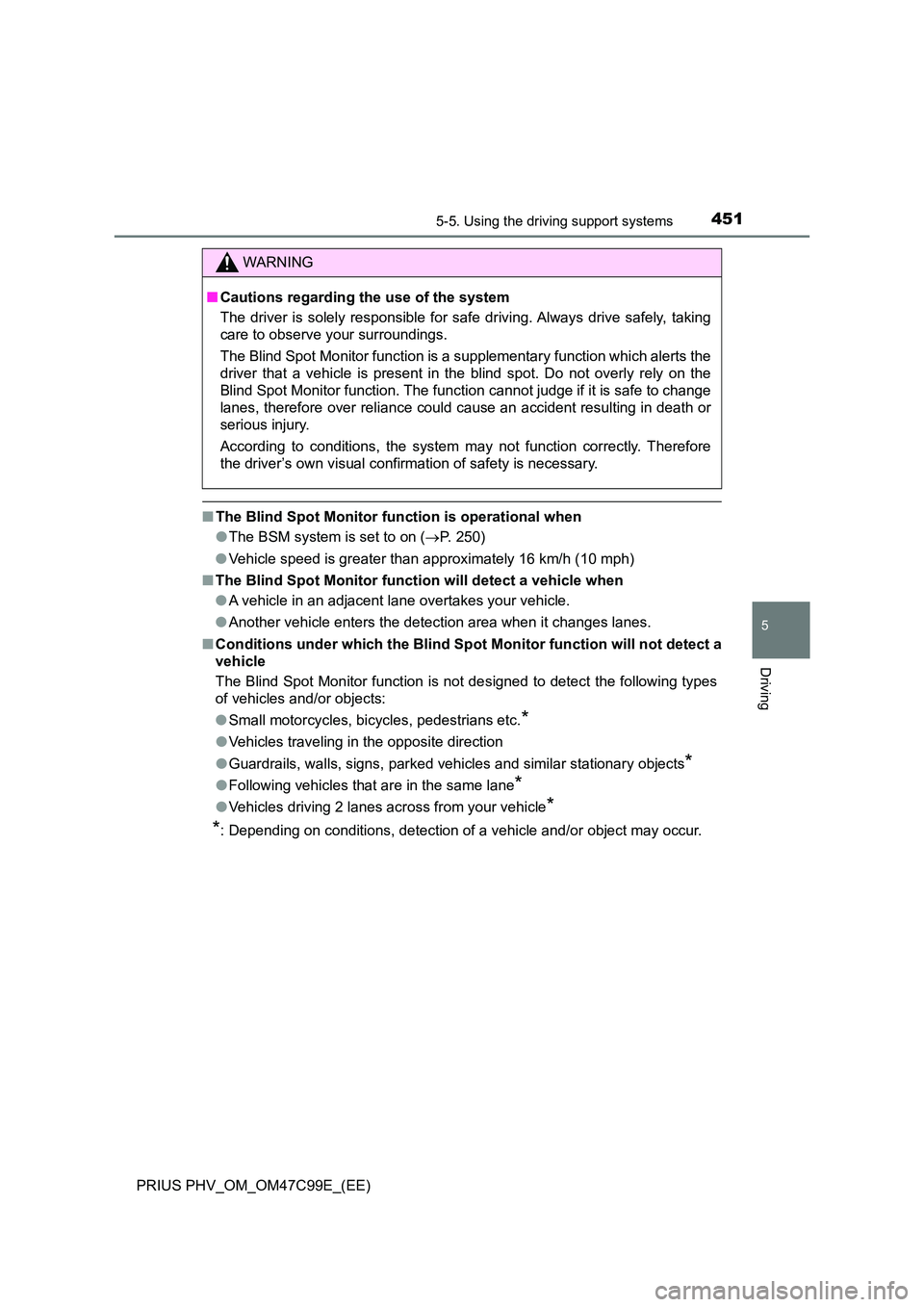
4515-5. Using the driving support systems
PRIUS PHV_OM_OM47C99E_(EE)
5
Driving
■The Blind Spot Monitor function is operational when
● The BSM system is set to on (P. 250)
● Vehicle speed is greater than approximately 16 km/h (10 mph)
■ The Blind Spot Monitor function will detect a vehicle when
● A vehicle in an adjacent lane overtakes your vehicle.
● Another vehicle enters the detection area when it changes lanes.
■ Conditions under which the Blind Spot Monitor function will not detect a
vehicle
The Blind Spot Monitor function is not designed to detect the following types
of vehicles and/or objects:
● Small motorcycles, bicycles, pedestrians etc.*
●Vehicles traveling in the opposite direction
● Guardrails, walls, signs, parked vehicles and similar stationary objects*
●Following vehicles that are in the same lane*
●Vehicles driving 2 lanes across from your vehicle*
*: Depending on conditions, detection of a vehicle and/or object may occur.
WARNING
■ Cautions regarding the use of the system
The driver is solely responsible for safe driving. Always drive safely, taking
care to observe your surroundings.
The Blind Spot Monitor function is a supplementary function which alerts the
driver that a vehicle is present in the blind spot. Do not overly rely on the
Blind Spot Monitor function. The functi on cannot judge if it is safe to change
lanes, therefore over reliance could cause an accident resulting in death or
serious injury.
According to conditions, the system may not function correctly. Therefore
the driver’s own visual confirmation of safety is necessary.
Page 452 of 772
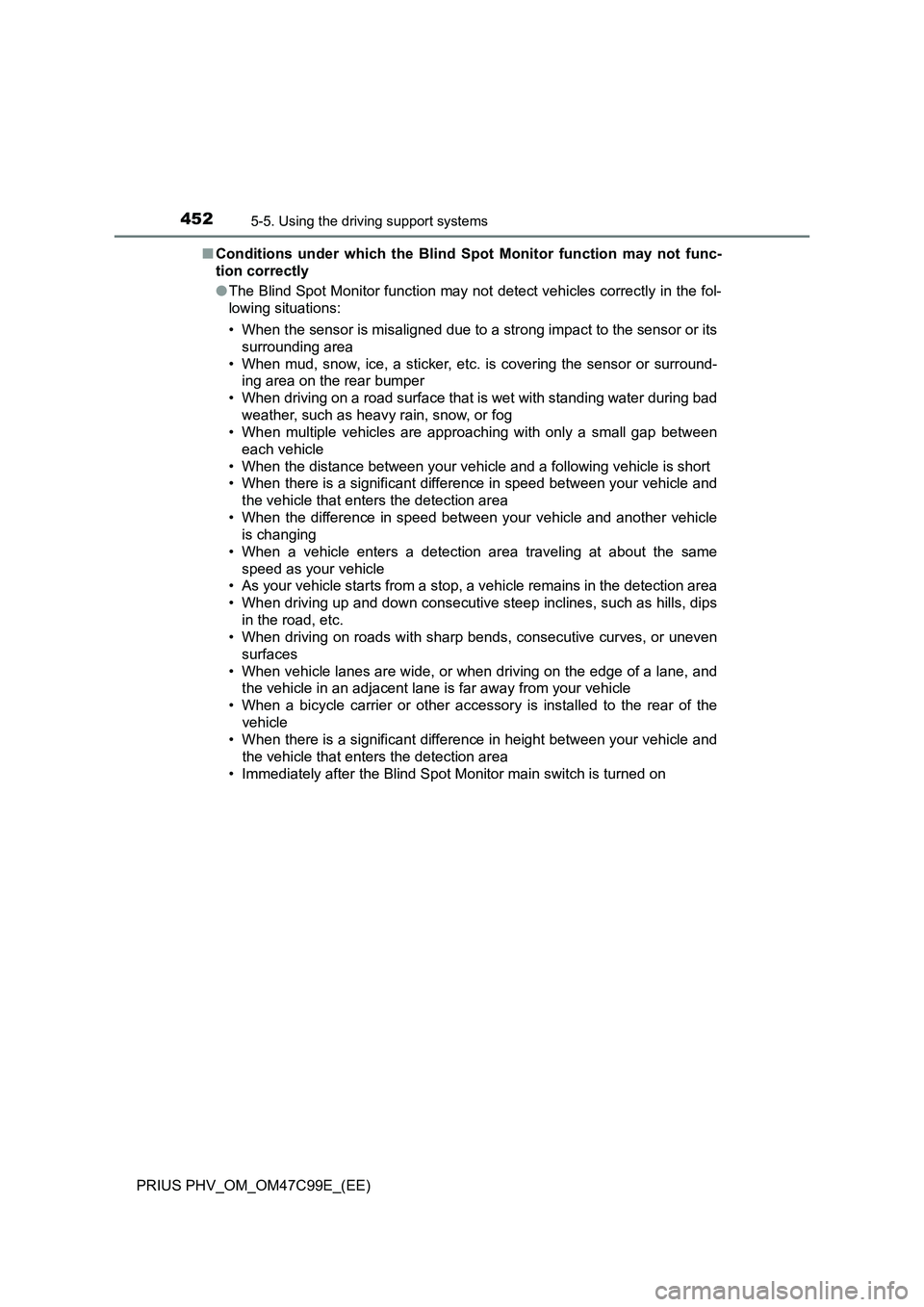
4525-5. Using the driving support systems
PRIUS PHV_OM_OM47C99E_(EE)■Conditions under which the Blind Spot Monitor function may not func-
tion correctly
●The Blind Spot Monitor function may not detect vehicles correctly in the fol-
lowing situations:
• When the sensor is misaligned due to a strong impact to the sensor or its
surrounding area
• When mud, snow, ice, a sticker, etc. is covering the sensor or surround-
ing area on the rear bumper
• When driving on a road surface that is wet with standing water during bad
weather, such as heavy rain, snow, or fog
• When multiple vehicles are approaching with only a small gap between
each vehicle
• When the distance between your vehicle and a following vehicle is short
• When there is a significant difference in speed between your vehicle and
the vehicle that enters the detection area
• When the difference in speed between your vehicle and another vehicle
is changing
• When a vehicle enters a detection area traveling at about the same
speed as your vehicle
• As your vehicle starts from a stop, a vehicle remains in the detection area
• When driving up and down consecutive steep inclines, such as hills, dips
in the road, etc.
• When driving on roads with sharp bends, consecutive curves, or uneven
surfaces
• When vehicle lanes are wide, or when driving on the edge of a lane, and
the vehicle in an adjacent lane is far away from your vehicle
• When a bicycle carrier or other accessory is installed to the rear of the
vehicle
• When there is a significant difference in height between your vehicle and
the vehicle that enters the detection area
• Immediately after the Blind Spot Monitor main switch is turned on
Page 453 of 772
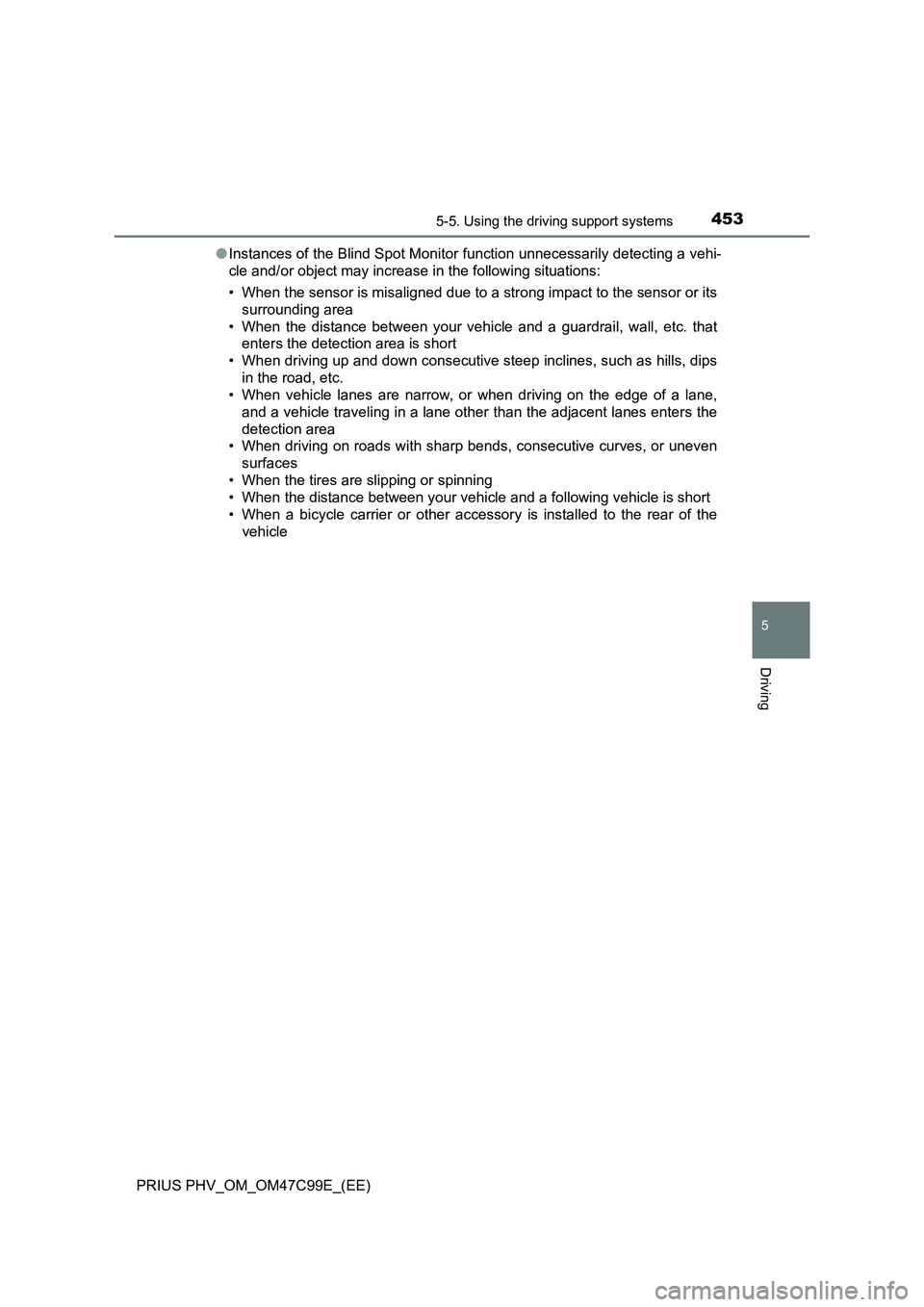
4535-5. Using the driving support systems
PRIUS PHV_OM_OM47C99E_(EE)
5
Driving
●Instances of the Blind Spot Monitor function unnecessarily detecting a vehi-
cle and/or object may increase in the following situations:
• When the sensor is misaligned due to a strong impact to the sensor or its
surrounding area
• When the distance between your vehicle and a guardrail, wall, etc. that
enters the detection area is short
• When driving up and down consecutive steep inclines, such as hills, dips
in the road, etc.
• When vehicle lanes are narrow, or when driving on the edge of a lane,
and a vehicle traveling in a lane other than the adjacent lanes enters the
detection area
• When driving on roads with sharp bends, consecutive curves, or uneven
surfaces
• When the tires are slipping or spinning
• When the distance between your vehicle and a following vehicle is short
• When a bicycle carrier or other accessory is installed to the rear of the
vehicle
Page 454 of 772
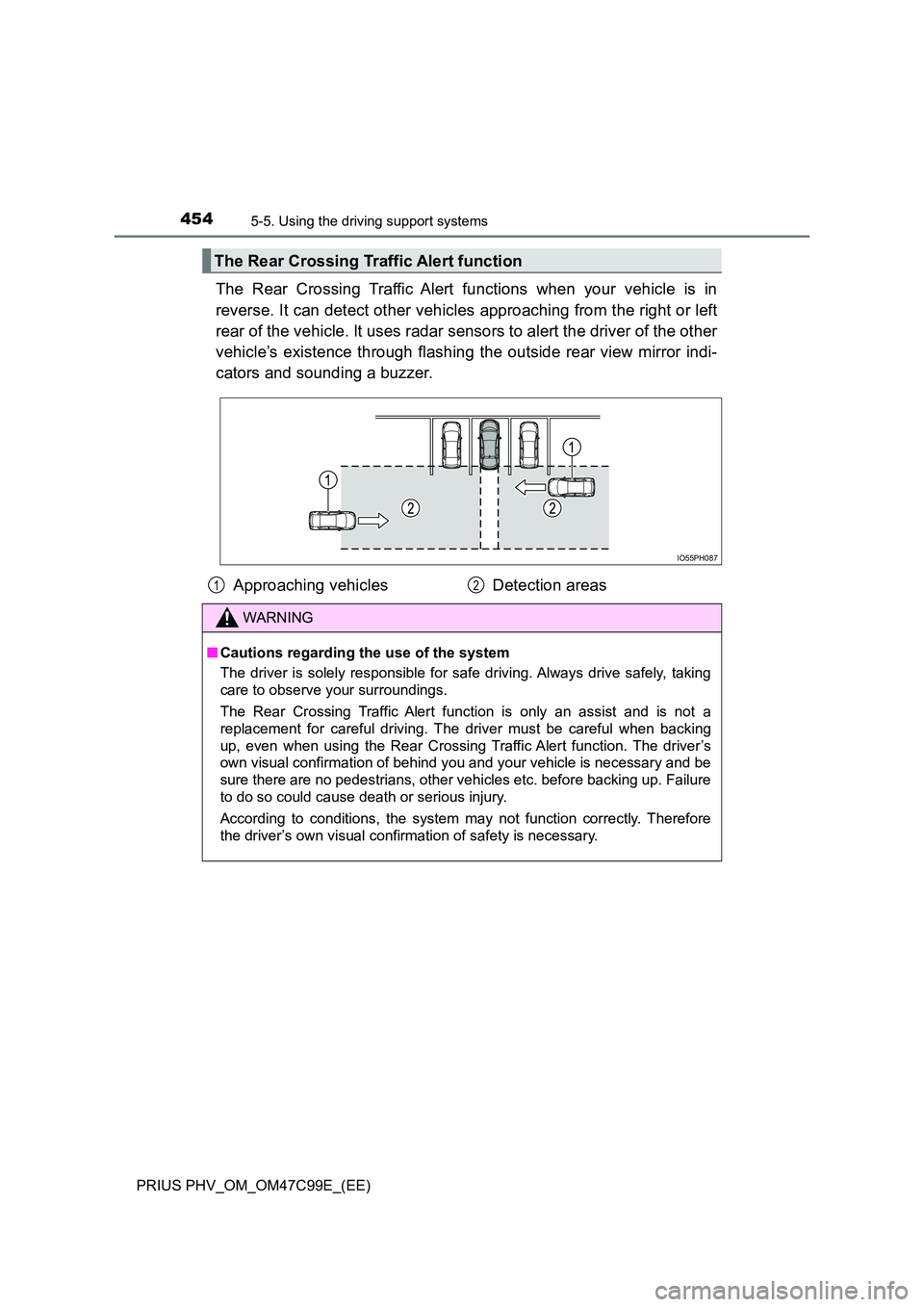
4545-5. Using the driving support systems
PRIUS PHV_OM_OM47C99E_(EE)
The Rear Crossing Traffic Alert functions when your vehicle is in
reverse. It can detect other vehicles approaching from the right or left
rear of the vehicle. It uses radar sensors to alert the driver of the other
vehicle’s existence through flashing the outside rear view mirror indi-
cators and sounding a buzzer.
The Rear Crossing Traffic Alert function
IO55PH087
Approaching vehicles Detection areas
WARNING
■ Cautions regarding the use of the system
The driver is solely responsible for safe driving. Always drive safely, taking
care to observe your surroundings.
The Rear Crossing Traffic Alert function is only an assist and is not a
replacement for careful driving. The driver must be careful when backing
up, even when using the Rear Crossing Traffic Alert function. The driver’s
own visual confirmation of behind you and your vehicle is necessary and be
sure there are no pedestrians, other vehicles etc. before backing up. Failure
to do so could cause death or serious injury.
According to conditions, the system may not function correctly. Therefore
the driver’s own visual confirmation of safety is necessary.
12
Page 455 of 772
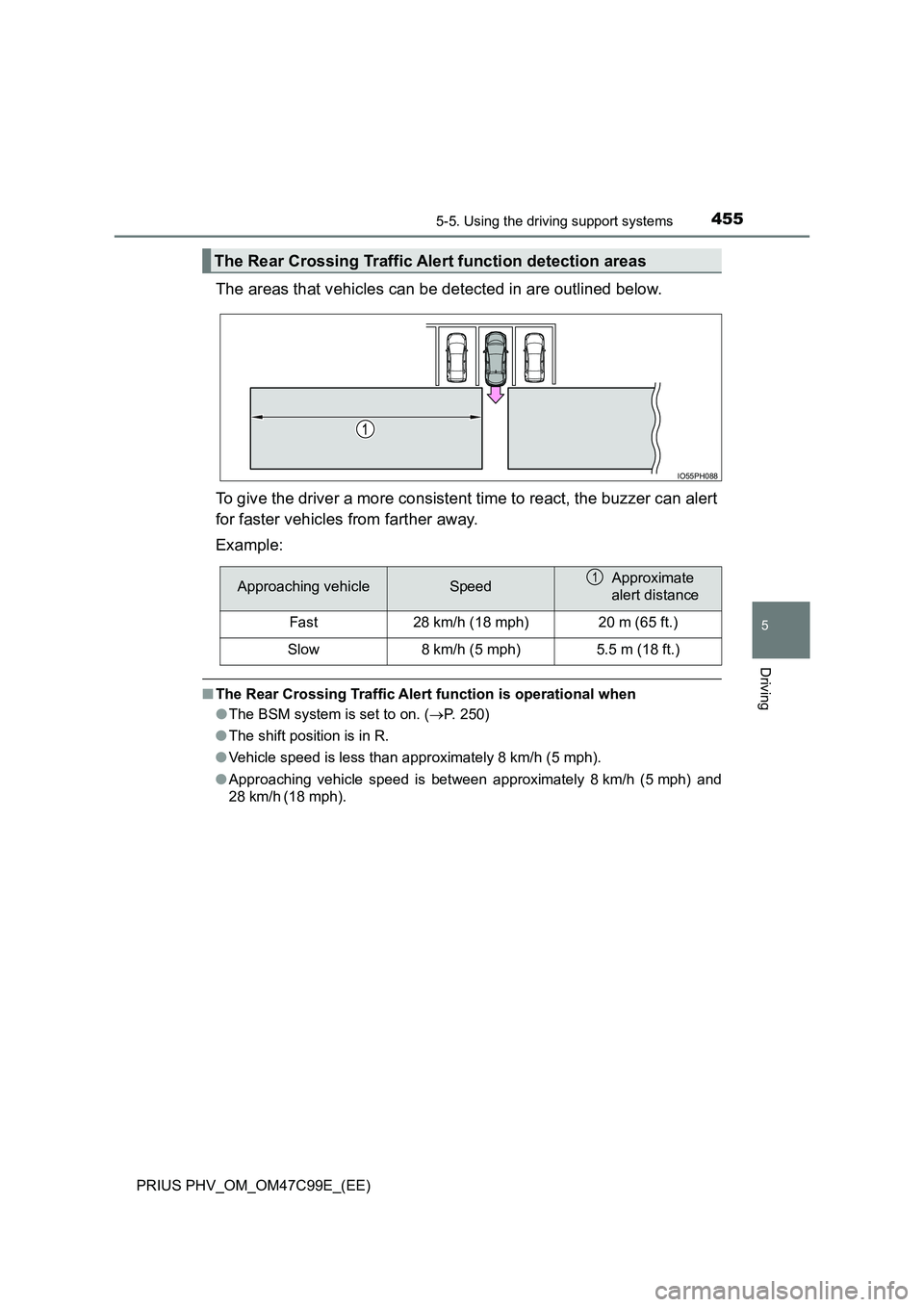
4555-5. Using the driving support systems
PRIUS PHV_OM_OM47C99E_(EE)
5
Driving
The areas that vehicles can be detected in are outlined below.
To give the driver a more consistent time to react, the buzzer can alert
for faster vehicles from farther away.
Example:
■ The Rear Crossing Traffic Alert function is operational when
● The BSM system is set to on. (P. 250)
● The shift position is in R.
● Vehicle speed is less than approximately 8 km/h (5 mph).
● Approaching vehicle speed is between approximately 8 km/h (5 mph) and
28 km/h (18 mph).
The Rear Crossing Traffic Alert function detection areas
IO55PH088
Approaching vehicleSpeedApproximate
alert distance
Fast28 km/h (18 mph)20 m (65 ft.)
Slow8 km/h (5 mph)5.5 m (18 ft.)
1
Page 456 of 772
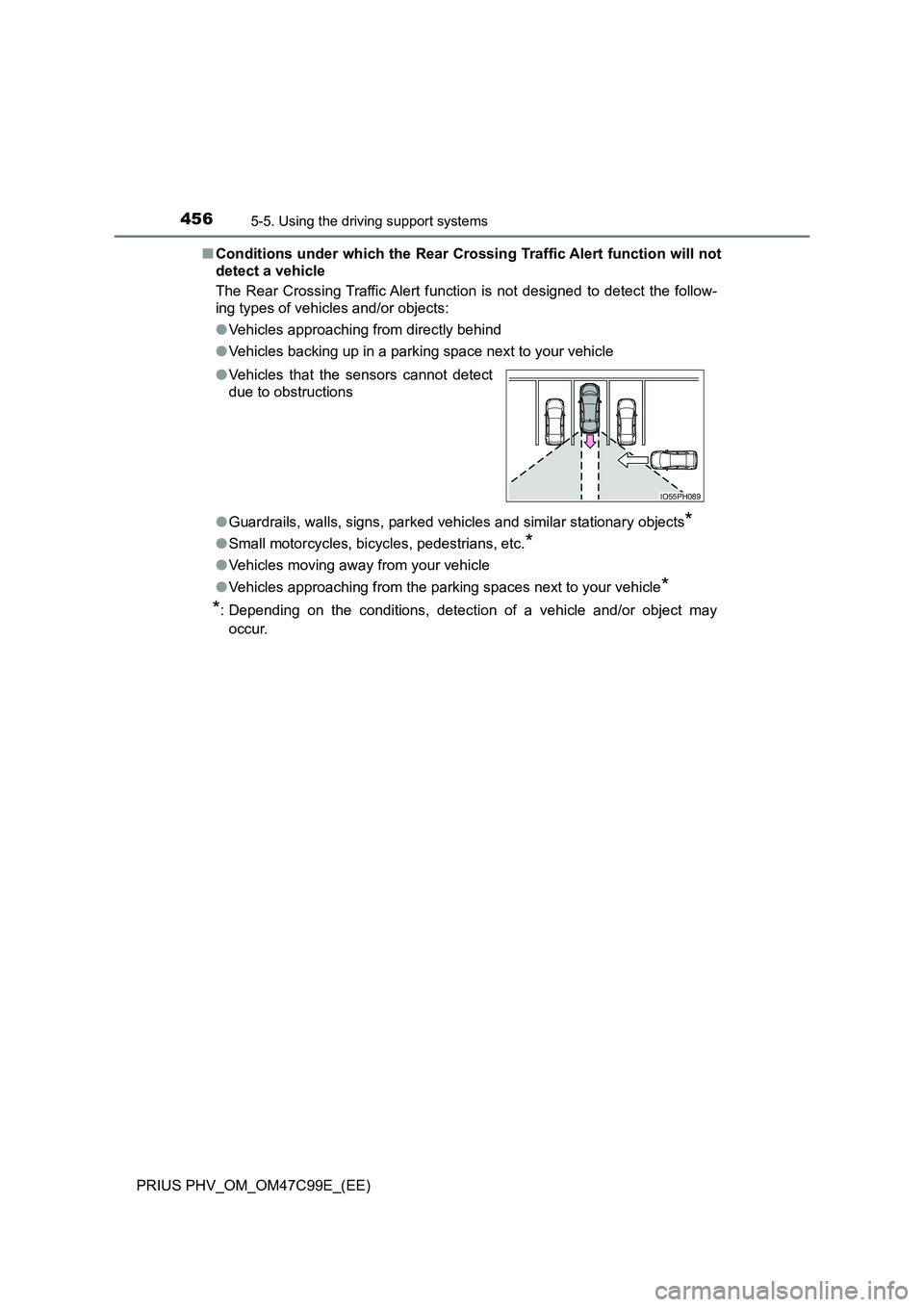
4565-5. Using the driving support systems
PRIUS PHV_OM_OM47C99E_(EE)
■ Conditions under which the Rear Crossing Traffic Alert function will not
detect a vehicle
The Rear Crossing Traffic Alert function is not designed to detect the follow-
ing types of vehicles and/or objects:
● Vehicles approaching from directly behind
● Vehicles backing up in a parking space next to your vehicle
● Guardrails, walls, signs, parked vehicles and similar stationary objects*
●Small motorcycles, bicycles, pedestrians, etc.*
●Vehicles moving away from your vehicle
● Vehicles approaching from the parking spaces next to your vehicle*
*: Depending on the conditions, detection of a vehicle and/or object may
occur.
● Vehicles that the sensors cannot detect
due to obstructions
IO55PH089
Page 457 of 772
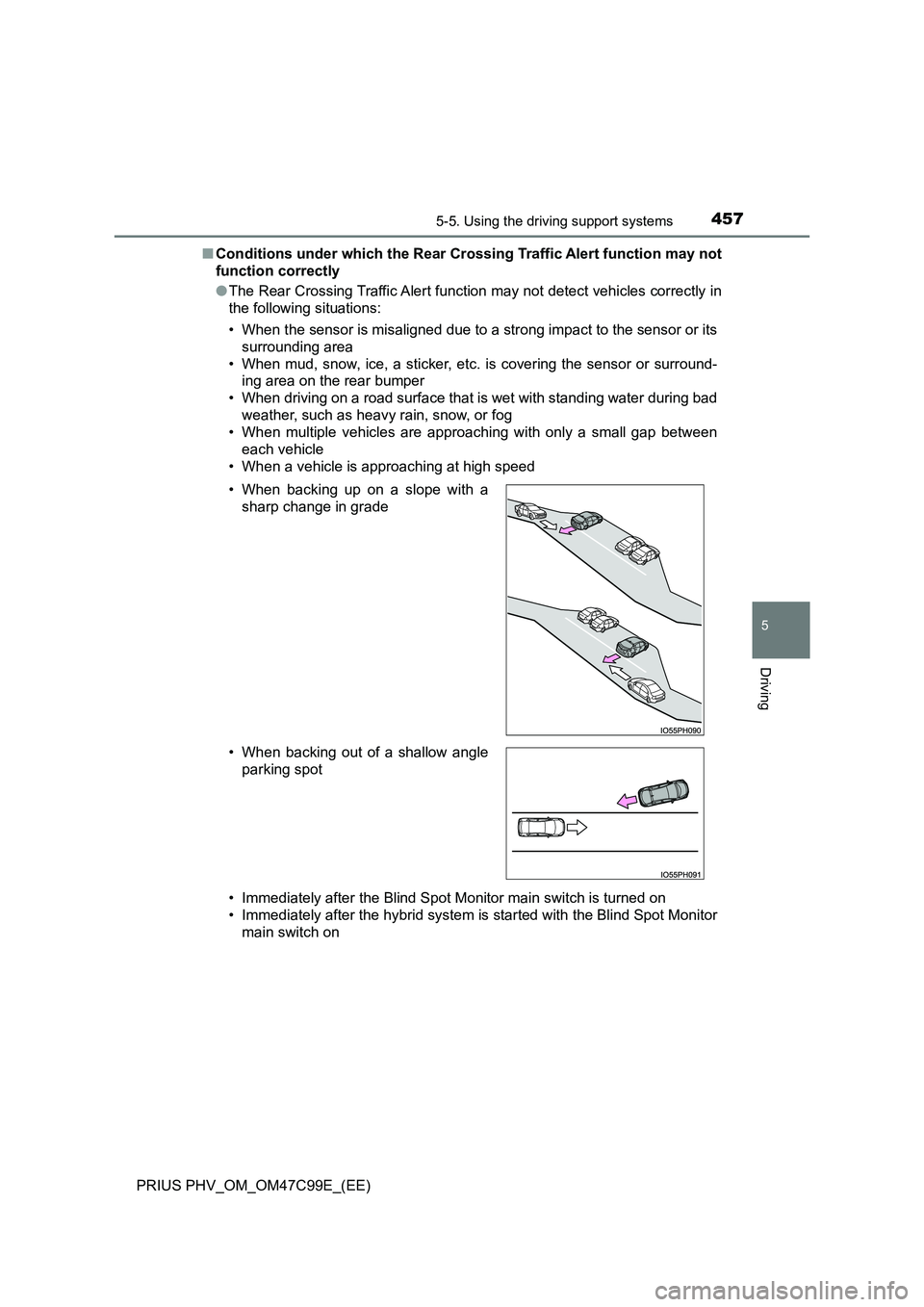
4575-5. Using the driving support systems
PRIUS PHV_OM_OM47C99E_(EE)
5
Driving
■Conditions under which the Rear Crossing Traffic Alert function may not
function correctly
● The Rear Crossing Traffic Alert function may not detect vehicles correctly in
the following situations:
• When the sensor is misaligned due to a strong impact to the sensor or its
surrounding area
• When mud, snow, ice, a sticker, etc. is covering the sensor or surround-
ing area on the rear bumper
• When driving on a road surface that is wet with standing water during bad
weather, such as heavy rain, snow, or fog
• When multiple vehicles are approaching with only a small gap between
each vehicle
• When a vehicle is approaching at high speed
• Immediately after the Blind Spot Monitor main switch is turned on
• Immediately after the hybrid system is started with the Blind Spot Monitor
main switch on
• When backing up on a slope with a
sharp change in grade
• When backing out of a shallow angle
parking spot
Page 458 of 772
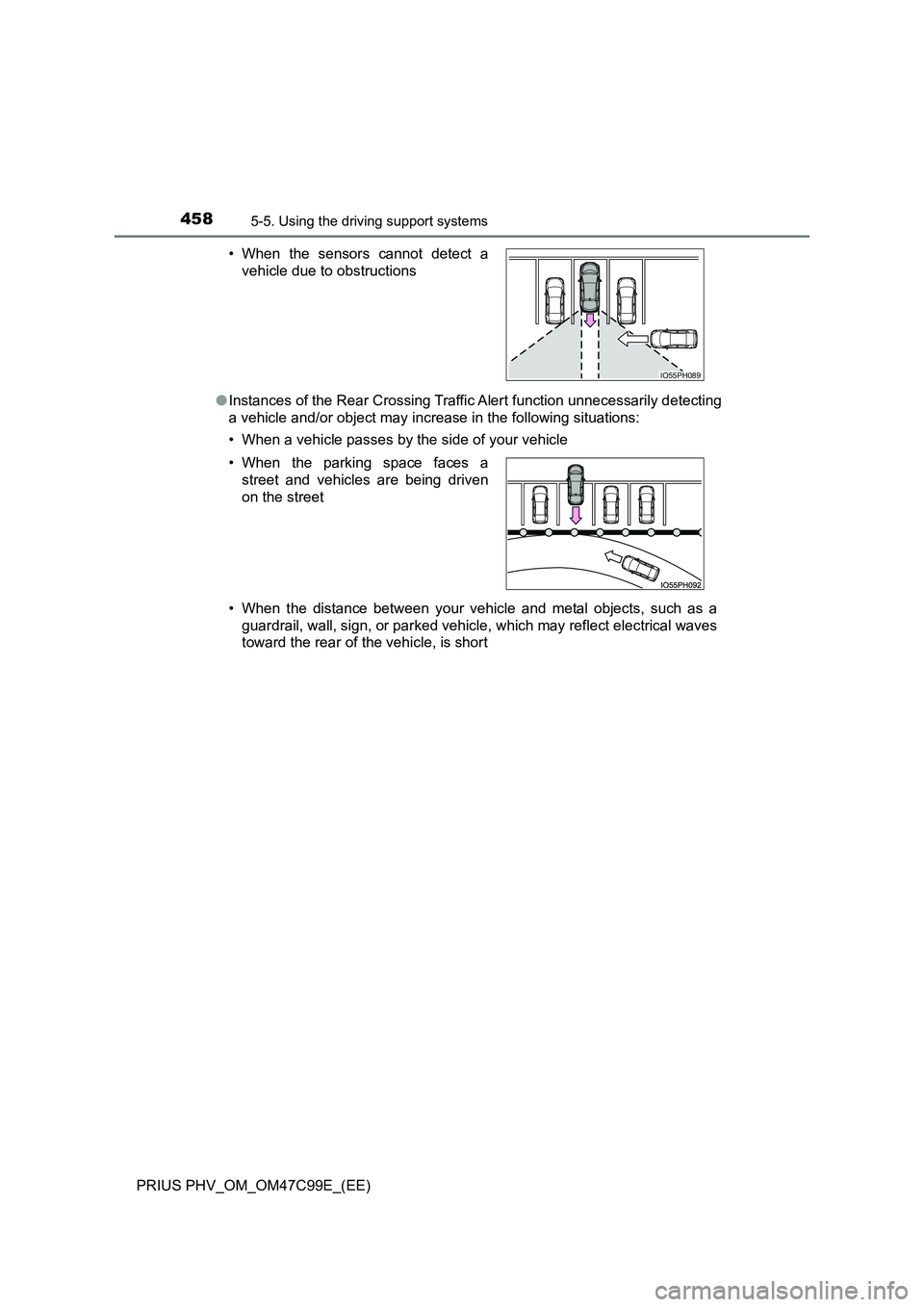
4585-5. Using the driving support systems
PRIUS PHV_OM_OM47C99E_(EE)
● Instances of the Rear Crossing Traffic Alert function unnecessarily detecting
a vehicle and/or object may increase in the following situations:
• When a vehicle passes by the side of your vehicle
• When the distance between your vehicle and metal objects, such as a
guardrail, wall, sign, or parked vehicle, which may reflect electrical waves
toward the rear of the vehicle, is short
• When the sensors cannot detect a
vehicle due to obstructions
• When the parking space faces a
street and vehicles are being driven
on the street
IO55PH089
Page 459 of 772
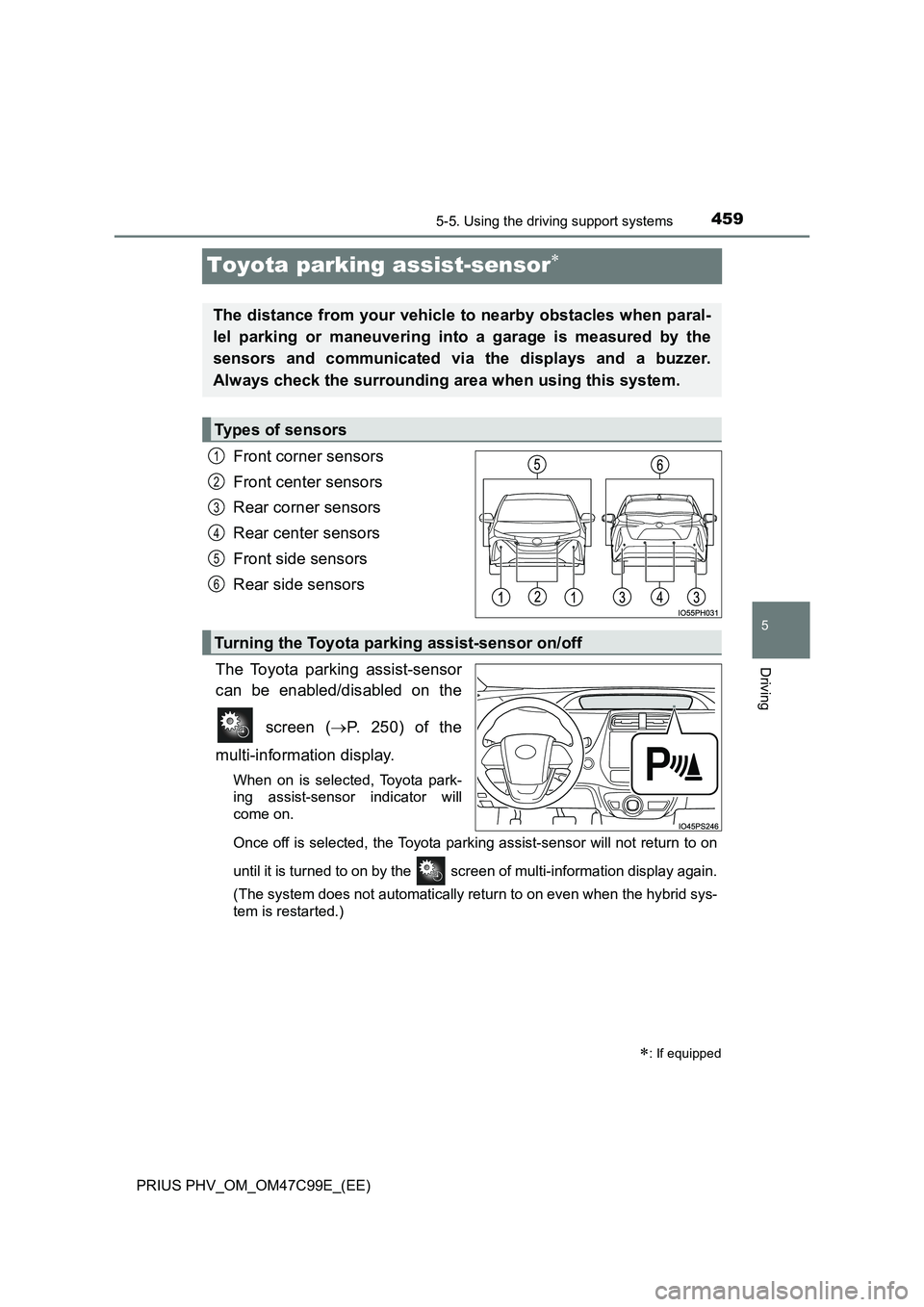
4595-5. Using the driving support systems
PRIUS PHV_OM_OM47C99E_(EE)
5
Driving
Toyota parking assist-sensor
Front corner sensors
Front center sensors
Rear corner sensors
Rear center sensors
Front side sensors
Rear side sensors
The Toyota parking assist-sensor
can be enabled/disabled on the
screen ( P. 250) of the
multi-information display.
When on is selected, Toyota park-
ing assist-sensor indicator will
come on.
Once off is selected, the Toyota parking assist-sensor will not return to on
until it is turned to on by the screen of multi-information display again.
(The system does not automatically return to on even when the hybrid sys-
tem is restarted.)
: If equipped
The distance from your vehicle to nearby obstacles when paral-
lel parking or maneuvering into a garage is measured by the
sensors and communicated via the displays and a buzzer.
Always check the surrounding area when using this system.
Types of sensors
1
2
3
4
5
6
Turning the Toyota parking assist-sensor on/off
Page 460 of 772
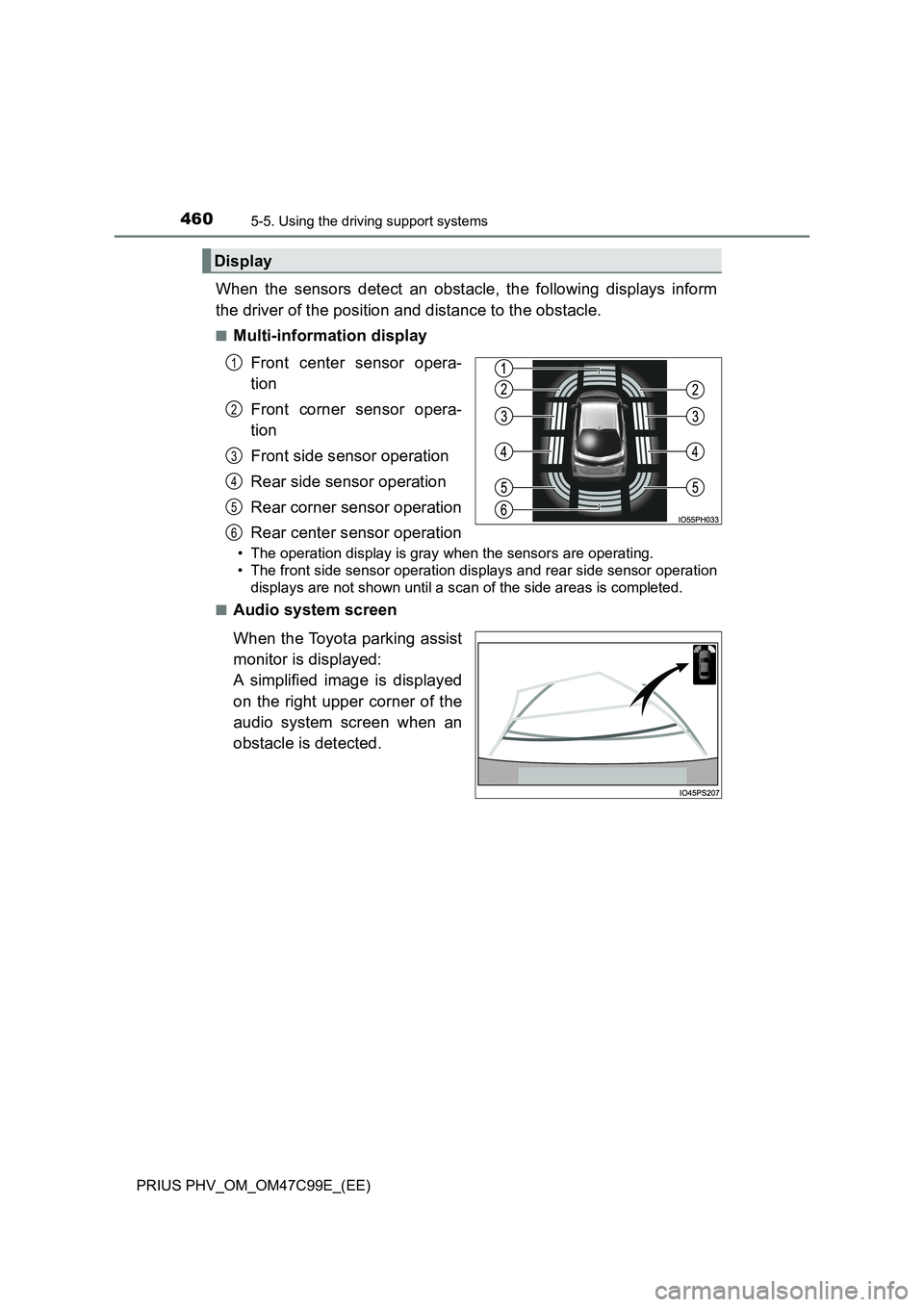
4605-5. Using the driving support systems
PRIUS PHV_OM_OM47C99E_(EE)
When the sensors detect an obstacle, the following displays inform
the driver of the position and distance to the obstacle.
■Multi-information display
Front center sensor opera-
tion
Front corner sensor opera-
tion
Front side sensor operation
Rear side sensor operation
Rear corner sensor operation
Rear center sensor operation
• The operation display is gray when the sensors are operating.
• The front side sensor operation displays and rear side sensor operation
displays are not shown until a scan of the side areas is completed.
■
Audio system screen
When the Toyota parking assist
monitor is displayed:
A simplified image is displayed
on the right upper corner of the
audio system screen when an
obstacle is detected.
Display
1
2
3
4
5
6